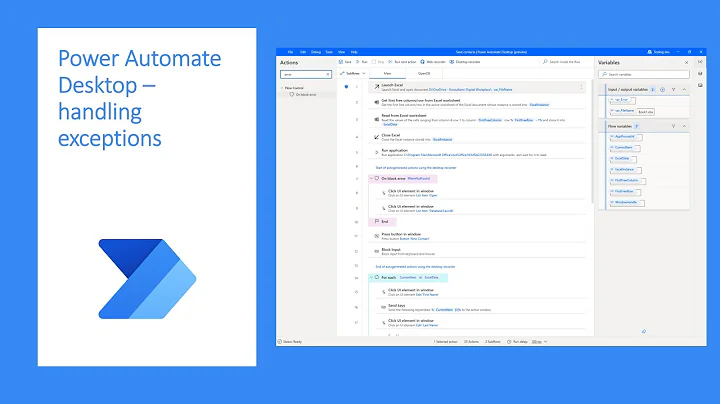Catching FULL exception message
Solution 1
Errors and exceptions in PowerShell are structured objects. The error message you see printed on the console is actually a formatted message with information from several elements of the error/exception object. You can (re-)construct it yourself like this:
$formatstring = "{0} : {1}`n{2}`n" +
" + CategoryInfo : {3}`n" +
" + FullyQualifiedErrorId : {4}`n"
$fields = $_.InvocationInfo.MyCommand.Name,
$_.ErrorDetails.Message,
$_.InvocationInfo.PositionMessage,
$_.CategoryInfo.ToString(),
$_.FullyQualifiedErrorId
$formatstring -f $fields
If you just want the error message displayed in your catch block you can simply echo the current object variable (which holds the error at that point):
try {
...
} catch {
$_
}
If you need colored output use Write-Host with a formatted string as described above:
try {
...
} catch {
...
Write-Host -Foreground Red -Background Black ($formatstring -f $fields)
}
With that said, usually you don't want to just display the error message as-is in an exception handler (otherwise the -ErrorAction Stop would be pointless). The structured error/exception objects provide you with additional information that you can use for better error control. For instance you have $_.Exception.HResult with the actual error number. $_.ScriptStackTrace and $_.Exception.StackTrace, so you can display stacktraces when debugging. $_.Exception.InnerException gives you access to nested exceptions that often contain additional information about the error (top level PowerShell errors can be somewhat generic). You can unroll these nested exceptions with something like this:
$e = $_.Exception
$msg = $e.Message
while ($e.InnerException) {
$e = $e.InnerException
$msg += "`n" + $e.Message
}
$msg
In your case the information you want to extract seems to be in $_.ErrorDetails.Message. It's not quite clear to me if you have an object or a JSON string there, but you should be able to get information about the types and values of the members of $_.ErrorDetails by running
$_.ErrorDetails | Get-Member
$_.ErrorDetails | Format-List *
If $_.ErrorDetails.Message is an object you should be able to obtain the message string like this:
$_.ErrorDetails.Message.message
otherwise you need to convert the JSON string to an object first:
$_.ErrorDetails.Message | ConvertFrom-Json | Select-Object -Expand message
Depending what kind of error you're handling, exceptions of particular types might also include more specific information about the problem at hand. In your case for instance you have a WebException which in addition to the error message ($_.Exception.Message) contains the actual response from the server:
PS C:\> $e.Exception | Get-Member
TypeName: System.Net.WebException
Name MemberType Definition
---- ---------- ----------
Equals Method bool Equals(System.Object obj), bool _Exception.E...
GetBaseException Method System.Exception GetBaseException(), System.Excep...
GetHashCode Method int GetHashCode(), int _Exception.GetHashCode()
GetObjectData Method void GetObjectData(System.Runtime.Serialization.S...
GetType Method type GetType(), type _Exception.GetType()
ToString Method string ToString(), string _Exception.ToString()
Data Property System.Collections.IDictionary Data {get;}
HelpLink Property string HelpLink {get;set;}
HResult Property int HResult {get;}
InnerException Property System.Exception InnerException {get;}
Message Property string Message {get;}
Response Property System.Net.WebResponse Response {get;}
Source Property string Source {get;set;}
StackTrace Property string StackTrace {get;}
Status Property System.Net.WebExceptionStatus Status {get;}
TargetSite Property System.Reflection.MethodBase TargetSite {get;}
which provides you with information like this:
PS C:\> $e.Exception.Response
IsMutuallyAuthenticated : False
Cookies : {}
Headers : {Keep-Alive, Connection, Content-Length, Content-T...}
SupportsHeaders : True
ContentLength : 198
ContentEncoding :
ContentType : text/html; charset=iso-8859-1
CharacterSet : iso-8859-1
Server : Apache/2.4.10
LastModified : 17.07.2016 14:39:29
StatusCode : NotFound
StatusDescription : Not Found
ProtocolVersion : 1.1
ResponseUri : http://www.example.com/
Method : POST
IsFromCache : False
Since not all exceptions have the exact same set of properties you may want to use specific handlers for particular exceptions:
try {
...
} catch [System.ArgumentException] {
# handle argument exceptions
} catch [System.Net.WebException] {
# handle web exceptions
} catch {
# handle all other exceptions
}
If you have operations that need to be done regardless of whether an error occured or not (cleanup tasks like closing a socket or a database connection) you can put them in a finally block after the exception handling:
try {
...
} catch {
...
} finally {
# cleanup operations go here
}
Solution 2
I found it!
Simply print out $Error[0] for the last error message.
Solution 3
The following worked well for me
try {
asdf
} catch {
$string_err = $_ | Out-String
}
write-host $string_err
The result of this is the following as a string instead of an ErrorRecord object
asdf : The term 'asdf' is not recognized as the name of a cmdlet, function, script file, or operable program. Check the spelling of the name, or if a path was included, verify that the path is correct and try again.
At C:\Users\TASaif\Desktop\tmp\catch_exceptions.ps1:2 char:5
+ asdf
+ ~~~~
+ CategoryInfo : ObjectNotFound: (asdf:String) [], CommandNotFoundException
+ FullyQualifiedErrorId : CommandNotFoundException
Solution 4
I keep coming back to these questions trying to figure out where exactly the data I'm interested in is buried in what is truly a monolithic ErrorRecord structure. Almost all answers give piecemeal instructions on how to pull certain bits of data.
But I've found it immensely helpful to dump the entire object with ConvertTo-Json so that I can visually see LITERALLY EVERYTHING in a comprehensible layout.
try {
Invoke-WebRequest...
}
catch {
Write-Host ($_ | ConvertTo-Json)
}
Use ConvertTo-Json's -Depth parameter to expand deeper values, but use extreme caution going past the default depth of 2 :P
https://docs.microsoft.com/en-us/powershell/module/microsoft.powershell.utility/convertto-json
Solution 5
Option 1: Simple but effective, good enough for most purposes
try {1/0} catch { $_ | Format-List * -Force | Out-String }
Results in:
PSMessageDetails :
Exception : System.Management.Automation.RuntimeException: Attempted to divide by zero. ---> System.DivideByZeroException: Attempted to divide by zero.
--- End of inner exception stack trace ---
at System.Management.Automation.ExceptionHandlingOps.CheckActionPreference(FunctionContext funcContext, Exception exception)
at System.Management.Automation.Interpreter.ActionCallInstruction`2.Run(InterpretedFrame frame)
at System.Management.Automation.Interpreter.EnterTryCatchFinallyInstruction.Run(InterpretedFrame frame)
at System.Management.Automation.Interpreter.EnterTryCatchFinallyInstruction.Run(InterpretedFrame frame)
TargetObject :
CategoryInfo : NotSpecified: (:) [], RuntimeException
FullyQualifiedErrorId : RuntimeException
ErrorDetails :
InvocationInfo : System.Management.Automation.InvocationInfo
ScriptStackTrace : at <ScriptBlock>, <No file>: line 1
PipelineIterationInfo : {}
Option 2: Also print the invocation info
try {1/0} catch { $_ | Format-List * -Force | Out-String ; $_.InvocationInfo | Format-List * -Force | Out-String }
Results in:
PSMessageDetails :
Exception : System.Management.Automation.RuntimeException: Attempted to divide by zero. ---> System.DivideByZeroException: Attempted to divide by zero.
--- End of inner exception stack trace ---
at System.Management.Automation.ExceptionHandlingOps.CheckActionPreference(FunctionContext funcContext, Exception exception)
at System.Management.Automation.Interpreter.ActionCallInstruction`2.Run(InterpretedFrame frame)
at System.Management.Automation.Interpreter.EnterTryCatchFinallyInstruction.Run(InterpretedFrame frame)
at System.Management.Automation.Interpreter.EnterTryCatchFinallyInstruction.Run(InterpretedFrame frame)
TargetObject :
CategoryInfo : NotSpecified: (:) [], RuntimeException
FullyQualifiedErrorId : RuntimeException
ErrorDetails :
InvocationInfo : System.Management.Automation.InvocationInfo
ScriptStackTrace : at <ScriptBlock>, <No file>: line 1
PipelineIterationInfo : {}
MyCommand :
BoundParameters : {}
UnboundArguments : {}
ScriptLineNumber : 1
OffsetInLine : 6
HistoryId : -1
ScriptName :
Line : try {1/0} catch { $_ | Format-List * -Force | Out-String ; $_.InvocationInfo | Format-List * -Force | Out-String }
PositionMessage : At line:1 char:6
+ try {1/0} catch { $_ | Format-List * -Force | Out-String ; $_.Invocat ...
+ ~~~
PSScriptRoot :
PSCommandPath :
InvocationName :
PipelineLength : 0
PipelinePosition : 0
ExpectingInput : False
CommandOrigin : Internal
DisplayScriptPosition :
Option 3: Both of the above plus all the inner exceptions
try {1/0} catch { $Exception = $_; $Exception | Format-List * -Force | Out-String ; $Exception.InvocationInfo | Format-List * -Force | Out-String ; for ($i = 0; $Exception; $i++, ($Exception = $Exception.InnerException)) { Write-Host ("$i" * 80) ; $Exception | Format-List * -Force | Out-String } }
PSMessageDetails :
Exception : System.Management.Automation.RuntimeException: Attempted to divide by zero. ---> System.DivideByZeroException: Attempted to divide by zero.
--- End of inner exception stack trace ---
at System.Management.Automation.ExceptionHandlingOps.CheckActionPreference(FunctionContext funcContext, Exception exception)
at System.Management.Automation.Interpreter.ActionCallInstruction`2.Run(InterpretedFrame frame)
at System.Management.Automation.Interpreter.EnterTryCatchFinallyInstruction.Run(InterpretedFrame frame)
at System.Management.Automation.Interpreter.EnterTryCatchFinallyInstruction.Run(InterpretedFrame frame)
TargetObject :
CategoryInfo : NotSpecified: (:) [], RuntimeException
FullyQualifiedErrorId : RuntimeException
ErrorDetails :
InvocationInfo : System.Management.Automation.InvocationInfo
ScriptStackTrace : at <ScriptBlock>, <No file>: line 1
PipelineIterationInfo : {}
MyCommand :
BoundParameters : {}
UnboundArguments : {}
ScriptLineNumber : 1
OffsetInLine : 6
HistoryId : -1
ScriptName :
Line : try {1/0} catch { $Exception = $_; $Exception | Format-List * -Force | Out-String ; $Exception.InvocationInfo | Format-List * -Force | Out-String ; for ($i = 0; $Exception;
$i++, ($Exception = $Exception.InnerException)) { Write-Host ("$i" * 80) ; $Exception | Format-List * -Force | Out-String } }
PositionMessage : At line:1 char:6
+ try {1/0} catch { $Exception = $_; $Exception | Format-List * -Force ...
+ ~~~
PSScriptRoot :
PSCommandPath :
InvocationName :
PipelineLength : 0
PipelinePosition : 0
ExpectingInput : False
CommandOrigin : Internal
DisplayScriptPosition :
00000000000000000000000000000000000000000000000000000000000000000000000000000000
PSMessageDetails :
Exception : System.Management.Automation.RuntimeException: Attempted to divide by zero. ---> System.DivideByZeroException: Attempted to divide by zero.
--- End of inner exception stack trace ---
at System.Management.Automation.ExceptionHandlingOps.CheckActionPreference(FunctionContext funcContext, Exception exception)
at System.Management.Automation.Interpreter.ActionCallInstruction`2.Run(InterpretedFrame frame)
at System.Management.Automation.Interpreter.EnterTryCatchFinallyInstruction.Run(InterpretedFrame frame)
at System.Management.Automation.Interpreter.EnterTryCatchFinallyInstruction.Run(InterpretedFrame frame)
TargetObject :
CategoryInfo : NotSpecified: (:) [], RuntimeException
FullyQualifiedErrorId : RuntimeException
ErrorDetails :
InvocationInfo : System.Management.Automation.InvocationInfo
ScriptStackTrace : at <ScriptBlock>, <No file>: line 1
PipelineIterationInfo : {}
Related videos on Youtube
JustAGuy
Updated on March 26, 2021Comments
-
JustAGuy about 3 years
Consider:
Invoke-WebRequest $sumoApiURL -Headers @{"Content-Type"= "application/json"} -Credential $cred -WebSession $webRequestSession -Method post -Body $sumojson -ErrorAction StopThis throws the following exception:
How can I catch it entirely or at least filter out the "A resource with the same name already exist."?
Using
$_.Exception.GetType().FullNameyieldsSystem.Net.WebException
and
$_.Exception.MessagegivesThe remote server returned an error: (400) Bad Request.
-
JustAGuy almost 8 yearsI already found the answer but this is by far more detailed. Cheers.
-
 Doug J. Huras about 7 yearsThanks for the thorough explanation. Very useful.
Doug J. Huras about 7 yearsThanks for the thorough explanation. Very useful. -
BrainSlugs83 almost 6 yearsInstead of calling
Write-Host -Foreground Red ...you should just use theWrite-Errorcmdlet. -- that will keep the output consistent across all host applications. -
 Ansgar Wiechers almost 6 years@BrainSlugs83
Ansgar Wiechers almost 6 years@BrainSlugs83Write-Errorwould throw a non-terminating error on top of displaying the message. That's something I wanted to avoid here. -
John Zabroski almost 6 yearsUp vote if you think PowerShell's default formatting of errors was designed to irritate C# engineers and encourage them to throw PowerShell into a blackhole.
-
BrainSlugs83 over 5 years@AnsgarWiechers
Write-Errordoesn't throw anything, it just writes output to the standard error stream. -- The default behavior is to print it like it threw something, but that's up to each environment to implement. If you are running PowerShell from a custom C# host it's super helpful if scripts write their text-based outputs to the proper streams. -
 Ansgar Wiechers over 5 years@BrainSlugs83
Ansgar Wiechers over 5 years@BrainSlugs83$ErrorActionPreference = 'Stop'; try {Write-Error 'foo'} catch {$_.GetType().FullName}You were saying? -
BrainSlugs83 over 5 yearsThat's very strange. It still behaves differently than
throw. --throwworks with try/catch even with$ErrorActionPreferenceisContinue, versus this only seems to work if it's set toStop? -- I hadn't realized the wordsnon-terminatingwere significant in your previous statement. -- Thanks for showing me this, I learned something new today. :-) -
 Ansgar Wiechers over 5 years@BrainSlugs83 Related. Also related.
Ansgar Wiechers over 5 years@BrainSlugs83 Related. Also related. -
BrainSlugs83 over 5 yearsThanks, @AnsgarWiechers!
-
ZakiMa over 5 yearsThis is the best approach - it catches both "throw <something>" and invocations.
-
 Ansgar Wiechers over 4 years@AltimusPrime What do you mean "how"?
Ansgar Wiechers over 4 years@AltimusPrime What do you mean "how"? -
Altimus Prime over 4 yearsI didn't know until now that you could execute multi-line code directly in PowerShell.
-
Robert K. Bell over 4 years
ConvertTo-Jsonwas failing me, withThe type 'System.Collections.ListDictionaryInternal' is not supported for serialization or deserialization of a dictionary. Keys must be strings.; I got what I needed by usingOut-Stringinstead. -
 eniacAvenger about 4 yearsPerfect, it gave me all the information I need, especially line number of the error.
eniacAvenger about 4 yearsPerfect, it gave me all the information I need, especially line number of the error. -
Jeetcu almost 4 yearsGreat... Much easier than anything :)
-
 JonoB almost 4 yearsYou might need to limit the depth of the JSON with the
JonoB almost 4 yearsYou might need to limit the depth of the JSON with the-Depthflag. I had examples of the JSON parsing taking gigabytes of RAM converting an ErrorRecord object in a Catch statement... -
galaxis about 2 yearsFor that output, all u need is "$_" (default Error object "ToString()") in the "catch". Assigning to a string variable like that would be handy tho, if say, u (also) wanted to write the msg to a log, change the color, etc.












